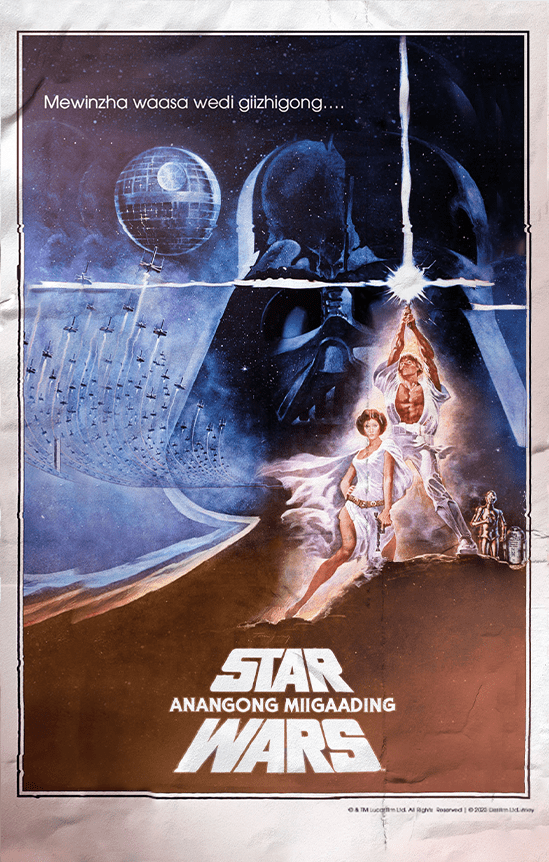The Dakota Ojibway Tribal Council and the University of Manitobahave partnered with Lucasfilm to give Star Wars a new dub in the Anishinaabemowin (Ojibwe) language!
Star Wars: A New Hope has been translated/dubbed into more than 50 languages over the years, and now they’re adding another! Marking only the second time the film has been dubbed in an indigenous language (the first being the Navajo version which is currently available on Disney+), Lucasfilm is working with The Dakota Ojibway Tribal Council and the University of Manitobahave on an Ojibwe version of the classic.
Much like with the Navajo version, the idea behind the dubb is a way of preserving the native language (Ojibwe being the third most common spoken in Canada) via pop-culture, while introducing newer generations to it. It’s just awesome. As an indigenous person myself, I absolutely love the idea, and especially love that Lucasfilm is officially helping.
Auditions for the new localization are happening soon, and open for sign-ups to locals who speak the language. You can learn more here at their official site. Below, you can find the full press release for the announcement:
Dakota Ojibway Tribal Council and the University of Manitoba announced today that they have an alliance with Disney/Lucasfilm to create an official Anishinaabemowin (Ojibwe) version of Star Wars: A New Hope. Auditions for voice actors are expected to take place during 2024 in Winnipeg, Man.
Partners in the project include Dakota Ojibway Tribal Council (DOTC), with Maeengan Linklater, Director of Operations, as the project lead; the University of Manitoba; Disney/Lucasfilm; and APTN.
The project is supported in part by the Government of Canada through the Indigenous Languages and Cultures Program from Canadian Heritage. Additional support will be provided by Disney/Lucasfilm and APTN.
“A New Hope, one of the most iconic movies of all time, being available in Anishinaabemowin (Ojibwe) will help showcase this language to the world,” says the Honourable Pascale St-Onge, Minister of Canadian Heritage. “It is my hope that this is just the beginning of many projects where stories are made available in First Nations, Métis and Inuit languages. Our government will always be there for communities in their efforts to cherish and revitalize their languages because they are an integral part of culture and identity and contribute to a sense of belonging.”
“Language is how knowledge is kept and handed down to future generations, within language we can hear our history and hopes for the future,” says the Honourable Dan Vandal, Minister of Northern Affairs and Minister responsible for PrairiesCan and CanNor. “Our government, together with our partners, are acting to remedy the damage that colonization has caused to Indigenous languages. Projects like this are crucial to revitalizing Indigenous languages and bringing them to new audiences so Indigenous Peoples can see themselves and their languages have a place at home and in a galaxy far, far away.”
Script translation, auditions for Anishinaabemowin voice actors and sound recording will take place in Winnipeg, with sound mixing and post-production scheduled to occur at Skywalker Sound in California. Plans are to have a Winnipeg premiere as well as showings at theatres across Canada and the intent is for this version of the film to air on APTN. Further details and timelines will be announced as the project progresses.
“This is an exciting project that seeks to restore the Anishinaabe language to the galaxy,” says Maeengan Linklater, “and, DOTC gets to say it did the Kessel Run in less than 12 parsecs.”
“Like the Force, our language surrounds us, penetrates us, and binds our communities and culture together,” says Cary Miller, Associate Vice-President Indigenous Scholarship, Research and Curriculum at the University of Manitoba. “Projects like this that make our language more accessible are foundationally important to encouraging our youth to carry on our knowledge – including that of science and technology – which are embedded in our Anishinaabe language.”
“Working on the Navajo version of Star Wars: A New Hope was a highlight of my career,” says Lucasfilm Senior Manager of Distribution Operations Michael Kohn. “I am very excited to revisit this type of project again and hopefully preserve and expand the Ojibwe language for future generations.”
“APTN is proud to partner on this project, which will help make a classic film more accessible to our Anishinaabe audience,” says Mike Omelus, executive director of content and strategy at APTN. “Language revitalization is fundamental to our work as an Indigenous broadcaster. This is an incredible way to celebrate Anishinaabe culture, language and identity.”
While there are many Indigenous languages in Canada, Anishinaabemowin, or Ojibwe, was chosen because it has about 320,000 speakers in Canada and the U.S., and is the most spoken Indigenous language in Manitoba, Ontario and Minnesota.
“Gi-ga-miinigoowiz Mamaandaawiziwin” (“May the Force be with you”).
Definitely going to have to keep an eye on this one’s progress!















